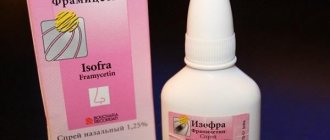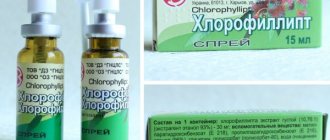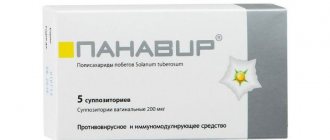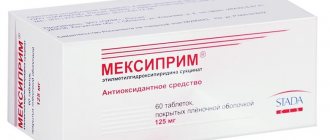Pharmacodynamics and pharmacokinetics
Pharmacodynamics
INN (international nonproprietary name) of the drug is Isosorbide dinitrate .
Isoket is a peripheral vasodilator that affects the venous vessels. Activates the synthesis of nitric oxide ( endothelial relaxing factor ) in the walls of blood vessels, stimulating intracellular guanylate cyclase , which leads to an increase in cGMP (vasodilatory mediator). Reduces the heart's need for oxygen due to reduced preload.
It has a coronary-dilating effect - it reduces the volume of blood arriving at the right atrium, lowers pressure in the pulmonary circulation, and causes regression of symptoms in pulmonary edema. Redistributes cardiac blood flow to tissues with reduced blood circulation. Reduces sensitivity to physical activity in individuals with coronary heart disease . Dilates cerebral vessels, which can cause headaches.
Cross-tolerance to the drug may develop, but after discontinuation of use, sensitivity to Isoket is restored. After spraying the spray onto the oral mucosa, the effect appears after 30 seconds and lasts up to two hours.
Pharmacokinetics
Spray Isoket. The degree of adsorption is high. Bioavailability – 60%. Binding to blood proteins - 31%. The half-life is one hour.
Isoketa concentrate after oral administration is absorbed from the intestine. The maximum concentration in the blood occurs after one hour. When used buccally, the maximum concentration occurs within 5-6 minutes.
Metabolized in the liver to isosorbide 5-mononitrate and isosorbide 2-mononitrate . The half-life depends on the dosage form used and can reach 4 hours. Excreted in urine and feces.
Instructions:
Clinical and pharmacological group
01.029 (Peripheral vasodilator. Antianginal drug)
Release form, composition and packaging
The spray is dosed in the form of a transparent, colorless solution with the smell of alcohol.
| 1 injection (1 dose) | |
| isosorbide dinitrate | 1.25 mg |
Excipients: macrogol 400, ethanol 100%.
15 ml (300 doses) - dark glass bottles with a dosing device (1) - cardboard packs.
pharmachologic effect
Peripheral vasodilator with a predominant effect on venous vessels. Stimulates the formation of nitric oxide (endothelial relaxing factor) in the vascular endothelium, which causes activation of intracellular guanylate cyclase, resulting in an increase in cGMP (a mediator of vasodilation). Reduces myocardial oxygen demand by reducing preload (reduces the end-diastolic volume of the left ventricle and reduces the systolic tension of its walls). Has a coronary dilating effect.
Reduces blood flow to the right atrium, helps reduce pressure in the pulmonary circulation and regression of symptoms of pulmonary edema. Promotes redistribution of coronary blood flow in areas with reduced blood circulation. Increases exercise tolerance in patients with coronary heart disease (including angina pectoris).
Dilates blood vessels in the brain and dura mater, which may be accompanied by headaches.
As with other nitrates, cross-tolerance develops. After cancellation (break in treatment), sensitivity to it is quickly restored.
After spraying onto the oral mucosa, the effect appears after 30 seconds and lasts 15-120 minutes.
Pharmacokinetics
Suction
Absorption is high. Bioavailability - 60%.
Distribution
Binding to blood plasma proteins is 30%.
Metabolism and excretion
It is metabolized in the liver with the formation of 2 active metabolites: isosorbide-5-mononitrate, whose share is 75-85%, T1/2 - 5 hours, and isosorbide-2-mononitrate, which is 15-25%, with T1/2 - 2.5 h.
T1/2 of isosorbide dinitrate is 60 min. It is excreted almost entirely in the urine as metabolites.
Dosage
To relieve an attack of angina or before physical or emotional stress that can cause an attack, you should inject the drug into the mouth 1-3 times with an interval of 30 seconds between injections while holding your breath. A single dose (3 injections) to relieve an attack can be increased only on the recommendation of a doctor.
In case of acute myocardial infarction and acute heart failure, 1-3 injections are prescribed under the control of blood pressure and heart rate. If there is no effect within 5 minutes, you can repeat the injection under the supervision of a physician. If improvement does not occur within 10 minutes, you can repeat the use of Isoket under blood pressure control.
Rules for using the drug
The aerosol should not be inhaled. It is necessary to bring the dispensing device (spray) close to your mouth, then take a deep breath, hold your breath and, pressing the sprayer, inject the aerosol into the oral cavity (this may cause a slight burning sensation on the tongue). Then you should close your mouth and breathe through your nose for about 30 seconds.
When using the drug for the first time and in the case when more than a day has passed since the last use of Isoket, when you first press the sprayer, you should direct the stream into the air (continuously and completely press the sprayer and release again). When using, the bottle should be held vertically, with the sprayer facing up.
Overdose
Symptoms: collapse, fainting, headache, dizziness, palpitations, visual disturbances, hyperthermia, convulsions, skin flushing, increased sweating, nausea, vomiting, diarrhea, methemoglobinemia (cyanosis, dyspnea), bradycardia, increased intracranial pressure, paralysis, coma.
Treatment: for methemoglobinemia - intravenous administration of 1% methylene blue at a dose of 1–2 mg/kg; In severe hypotension, phenylephrine (Mezaton), epinephrine (adrenaline) and related compounds are contraindicated.
Drug interactions
With simultaneous use of Isoket with other vasodilators (vasodilators), antihypertensive drugs, beta-blockers, slow calcium channel blockers, antipsychotics, tricyclic antidepressants, ethanol, procainamide, quinidine, phosphodiesterase inhibitors, the hypotensive effect may be enhanced.
When combining Isoket with amiodarone, propranolol, and slow calcium channel blockers (verapamil, nifedipine), the antianginal effect may be enhanced.
With simultaneous use of Isoket with sympathomimetics, alpha-blockers (dihydroergotamine), the severity of the antianginal effect may be reduced (due to a pronounced decrease in blood pressure, and, as a consequence, coronary perfusion).
With the combined use of Isoket with m-anticholinergic drugs (atropine), the likelihood of increased intracranial pressure increases.
It should be borne in mind that the data presented also apply to those cases when the drug was started recently.
Use during pregnancy and lactation
During pregnancy and breastfeeding, the use of Isoket is possible only in cases where the expected benefit to the mother significantly outweighs the possible risk to the fetus or child.
Experimental studies did not reveal any harmful effects on the fetus.
Side effects
From the cardiovascular system: upon first use or with an increase in dose, a decrease in blood pressure and the development of orthostatic hypotension may occur, which may be accompanied by a reflex increase in heart rate, lethargy, as well as dizziness and a feeling of weakness. At the beginning of treatment, headaches (“nitrate” headaches) may also appear, which, as a rule, disappear with further use of the drug.
Rarely, with a pronounced decrease in blood pressure, an increase in the symptoms of angina pectoris (paradoxical nitrate reaction) and collapse may be observed.
In some cases, collaptoid states are observed, sometimes with bradycardia and syncope (attacks with impaired consciousness, dizziness associated with cerebrovascular accident as a result of heart rhythm disturbances, primarily due to its significant slowdown).
From the digestive system: a slight burning sensation of the tongue, dry mouth may occur; rarely - nausea, vomiting.
From the central nervous system and peripheral nervous system: stiffness, drowsiness, blurred vision, decreased ability to make quick mental and motor reactions (especially at the beginning of treatment); rarely – cerebral ischemia.
Other: rarely - redness of the facial skin, feeling of heat, allergic skin reactions; in some cases - exfoliative dermatitis, development of tolerance (including cross-tolerance to other nitrates).
Storage conditions and periods
The drug should be stored out of the reach of children at a temperature not exceeding 25°C. Shelf life: 5 years.
It is necessary to periodically check the operation of the sprayer (especially after a long break in its use). There is an arrow at the bottom of the bottle label. When the liquid level in the bottle reaches the upper edge of the arrow, you need to purchase the next bottle of spray. Further use of such a bottle is possible as long as the tip of the suction tube is still immersed in the liquid when tilted slightly.
Indications
- relief of angina attacks;
- prevention of angina attacks;
— acute myocardial infarction (including complicated by acute left ventricular failure);
- condition after myocardial infarction.
Contraindications
- acute vascular insufficiency;
- severe arterial hypotension (systolic blood pressure below 90 mm Hg, diastolic blood pressure below 60 mm Hg);
- cardiogenic shock (if it is impossible to correct the end-diastolic pressure of the left ventricle using intra-aortic counterpulsation or drugs with a positive inotropic effect);
- deficiency of glucose-6-phosphate dehydrogenase;
— closed-angle form of glaucoma;
- hyperthyroidism;
- children and adolescents under 18 years of age (efficacy and safety have not been established);
- simultaneous use with phosphodiesterase type 5 inhibitors (for example, sildenafil), because in this case, the hypotensive effect of the drug may be enhanced;
- hypersensitivity to nitrate compounds or other components of the drug.
The drug should be used with caution and under the supervision of a physician in acute myocardial infarction with reduced ventricular filling pressure.
The drug should be prescribed with caution in hypertrophic obstructive cardiomyopathy, constrictive pericarditis, cardiac tamponade, aortic and/or mitral stenosis, a tendency to orthostatic reactions, in diseases that are accompanied by increased intracranial pressure (including hemorrhagic stroke, traumatic brain injury) , severe renal failure, liver failure (since the risk of developing methemoglobinemia increases), elderly patients.
special instructions
During the period of use of Isoket, it is necessary to monitor blood pressure and heart rate.
Abrupt withdrawal of the drug should be avoided; the drug should be discontinued gradually.
It should be borne in mind that frequent prescription and use of the drug in high doses may cause the development of tolerance. In this case, it is recommended to discontinue the drug for 24-48 hours, or after 3-6 weeks of regular use, take a break for 3-5 days, replacing Isoket with other antianginal drugs during this time.
Please note that the drug contains about 85% ethanol. Therefore, alcohol consumption should be avoided during treatment with Isoket.
Avoid contact of the drug with the eyes.
Each time you press the sprayer, an equal amount of solution is sprayed in the form of tiny droplets. It easily penetrates the mucous membrane of the mouth and enters the bloodstream in a matter of seconds.
Isocket does not contain freon and is environmentally friendly. The bottle is transparent, which allows you to notice the need for replacement in time.
Impact on the ability to drive vehicles and operate machinery
Peculiarities of an individual reaction to the drug can lead to impairment of the ability to drive vehicles or other machinery. This effect is significantly enhanced at the beginning of treatment, with increasing doses and changing the drug, as well as when combined with alcohol intake.
Use for renal impairment
The drug should be prescribed with caution in severe renal failure.
Use for liver dysfunction
The drug should be prescribed with caution in case of liver failure.
Conditions for dispensing from pharmacies
The drug is available with a prescription.
Contraindications
- Allergy to the components of the drug.
- Arterial hypotension.
- Acute form of vascular insufficiency .
- Glucose-6-phosphate dehydrogenase deficiency .
- Cardiogenic shock.
- Angle-closure glaucoma.
- Hyperthyroidism.
- Age less than 18 years.
Use with caution in obstructive hypertrophic cardiomyopathy ; cardiac tamponade; mitral or aortic stenosis; orthostatic reactions ; diseases complicated by increased intracranial pressure; renal or liver failure ; in old age.
Pregnancy and lactation
When developing the drug, scientists conducted animal studies. An experiment on subjects showed that there is no damaging effect on the fetus.
However, during pregnancy and the lactation period, the use of an aerosol is recommended only in situations where the expected benefit to the woman will significantly exceed the potential risk to the fetus or infant. Treatment in these cases should be carried out under the strict supervision of specialists who monitor blood circulation indicators (blood pressure and heart rate), as well as the general condition of the patient.
Side effects
When you first use or increase the dosage, you may develop orthostatic hypotension , a decrease in pressure, which may be complicated by an increase in pulse, lethargy, dizziness and weakness.
At the beginning of therapy, headaches, dry mouth and burning of the tongue sometimes develop.
Rarely, nausea, vomiting, facial flushing, fever , allergic reactions , and complications of angina .
Collapse , fainting , exfoliative dermatitis are even less common .
Special recommendations for using the spray
In cases where a new aerosol is used for the first time, or more than 24 hours have passed since the last dose, it is recommended that the first press be directed into the air, since it may not contain the required dosage. To receive a dose in accordance with the instructions, the nebulizer is pressed continuously until the end and then released. During use, the spray bottle should be positioned with the dispenser facing up and in a vertical position.
Be careful not to allow splashes to come into contact with your eyes. During the entire period of treatment, constant monitoring of blood pressure (BP) and an ECG are necessary. The blood pressure value should not be less than 100 mm Hg. Art. Abrupt withdrawal of the drug is prohibited by the instructions, so the prescribed doses are reduced gradually. Alcoholic drinks are contraindicated when taking Isoket aerosol.
Reviews from experts indicate that a high dosage of the drug, its frequent prescription or systematic use can lead to the development of tolerance in the patient. This feature also develops when using other drugs containing nitrates. In such situations, doctors recommend stopping the use of the drug for 2-3 days, and after a course of regular therapy that lasted 3-6 weeks, taking a break for 3-5 days and temporarily replacing it with other drugs of a similar effect. In most cases, after a break or discontinuation of therapy, the patient's sensitivity is restored fairly quickly. The components of the drug are excreted in the form of metabolites by the kidneys almost in full.
Instructions for use Isoket (Method and dosage)
Instructions for using the spray Izoket recommends spraying it onto the oral mucosa. Ampoules with Isoketa concentrate are allowed to be used buccally, sublingually, or intravenously .
Isoket spray should not be inhaled; it should be sprayed in the mouth. To treat or prevent an attack of angina , you need to inject the aerosol into the oral cavity up to 3 times at intervals of half a minute, holding your breath after each procedure.
In case of acute heart attack and acute heart failure, treatment begins with 1-3 similar procedures, monitoring blood pressure and cardiac activity. If there are no changes after 5 minutes, the injection may be repeated under medical supervision.
Isoketa concentrate for the preparation of infusion solution. A single dose can range from 10-120 mg, the frequency of administration is from 1 to 5 times a day.
With the buccal or sublingual route, a single dose is 5-10 mg, the frequency depends on the indications and sensitivity of the patient to Isoket.
When intravenously , the dosage of the drug depends on the clinical picture and dosage form.
For cutaneous use, the initial dose is 1 gram before bedtime, and if necessary in the morning.
The duration of therapy is determined individually.
Indications for use
Isoket spray is prescribed by specialists for angina attacks of all forms and as a preventive measure to avoid them. It is also recommended for post-infarction conditions, myocardial infarction in the acute stage, increasing tolerance during IMS and treating coronary artery spasm. Aerosol "Isoket" is successfully used as a medicine for heart failure in the left ventricle.
According to the instructions, the infusion concentrate is prescribed to patients with the following pathologies of the cardiovascular system:
- unstable angina, occurring in a pre-infarction state or preceding myocardial infarction;
- vasospastic angina;
- acute myocardial infarction caused by left ventricular failure;
- spasm of coronary vessels during surgical interventions;
- heart failure of all types;
- acute left ventricular heart failure;
- pulmonary edema.
Overdose
Symptoms: fainting, dizziness, palpitations, visual disturbances, hyperthermia , flushing, convulsions, sweating , diarrhea , vomiting , methemoglobinemia, bradycardia , paralysis , coma .
Therapy: for methemoglobinemia, intravenous administration of 1–2 mg/kg of a 1% solution of methylene blue . Symptomatic therapy.
Interaction
When using Isoket:
- with vasodilators, antipsychotics, calcium channel blockers, antihypertensive drugs, β-blockers , procainamide , quinidine , tricyclic antidepressants , the hypotensive effect may be enhanced;
- with propranolol , amiodarone , calcium channel blockers ( Nifedipine , Verapamil ), the antianginal effect may be enhanced;
- with sympathomimetics and α-blockers, a decrease in the antianginal effect is possible;
- with m-anticholinergics, the likelihood of an increase in intracranial pressure increases.
Price
In Russian pharmacies you will have to pay from 365 to 470 rubles for one dosed drug “Isoket” (spray). The price is determined depending on the location of the outlet and its status. On websites selling medicines, it can be purchased at a lower cost than in a regular pharmacy near your home. But when ordering online, you will have to pay about 200 rubles for delivery or receive the product for free at a pickup point, which is not always geographically conveniently located.
You can also purchase a package (10 ampoules) of concentrated solution for infusion “Isoket” at any pharmacy. The price for it ranges from 906-980 rubles.
Analogs
Level 4 ATC code matches:
Nitrospray
Nitroglycerine
Efox
Monosan
Nitromint
Pectrol
Erinite
Cardiket
Sustak Forte
Nitrosorbide
The most common analogues of Isoket are Izodinit and Kardiket, Retard .
Why did Izoket spray disappear?
Starting in the summer of 2021, patients visit pharmacies with bewilderment: “where is isoket spray?”, “where did isoket spray go?” Gradually, when supplies of the drug ran out for all patients, it became clear that the medicine was not available anywhere - neither in city pharmacies, nor in online pharmacies. The spray is not available even from federal distributors.
Regional media reported back in the summer that the drug’s registration period had expired and the manufacturer was re-registering it. But wait, it’s 2021, and the drug was still not in pharmacies. And the state registration of the drug, renewed on November 9, 2017, is still valid. Yes, it is possible that changes are being made to the registration certificate... But is it really possible to do this for more than 6 months!? Hard to believe.
It is also unlikely that due to technological failures in production, domestic distributors have not received the next batch of Isoket for more than six months.
And now the most interesting thing is that Izoket spray is not on sale not only in Russia. It is not available anywhere, not even in Germany, where this drug is produced. Most likely the manufacturer has problems with raw materials - either they have become too expensive, or for some reason they cannot yet reach Germany. Therefore, it is unknown when Izoket spray will appear in pharmacies.
Update from 01/07/20: According to information provided to Rossiyskaya Gazeta by a representative of the pharmaceutical company, interruptions in the supply of the drug are not related to its quality or safety. There is also no talk of re-registration of the spray. The medicine should be available to distributors at the end of March 2021 (editor's note - the drug will arrive at pharmacies a little later).
Isoketa price, where to buy
The price of Isoket spray in Russia is 365-325 rubles, and in Ukraine 155-185 hryvnia. Isocket for infusions costs 971-1026 rubles and 350-400 hryvnia in Russia and Ukraine, respectively.
- Online pharmacies in RussiaRussia
- Online pharmacies in UkraineUkraine
- Online pharmacies in KazakhstanKazakhstan
LuxPharma* special offer
- Isoket spray 1.25 mg/dose 300 doses vial.
15 ml 2780 rub. order
show more
Pharmacy24
- Isoket 0.1% 10 ml N10 solution for infusion Eysika Pharmaceuticals GmbH, Nimetchina
434 UAH.order - Isoket 15 ml (300 doses) spray Eysika Pharmaceuticals GmbH, Nimecchina
335 UAH. order
PaniPharmacy
- Isoket infusion Isoket solution inf. 0.1% amp. 10ml No. 10 Germany, Aesica Pharmaceuticals
446 UAH. order
- Isoket aerosol Isoket aer. 300 doses Germany, Aesica Pharmaceuticals
354 UAH. order
show more
Release form
The drug is a clear, colorless solution with an alcoholic odor. It is available in two varieties:
- Isoket spray is sublingual and dosed. With one click on the dispenser, one dose is released in the form of tiny drops, which consists of 1.25 mg of the active ingredient - isosorbide dinitrate, as well as auxiliary elements: ethanol and macrogol 400. The aerosol does not contain freon, therefore it is a harmless drug for the environment. Available in transparent 15 ml bottles, packed in a box with a dispenser and instructions. The glass bottle, designed for 300 clicks (doses), allows you to monitor the amount of the drug and promptly purchase a replacement.
- A solution in the form of a concentrate intended for infusion. 1 ml of this drug contains 1 mg of the active element isosorbide dinitrate and additional substances: sodium chloride, sodium hydroxide, water. One ampoule contains 10 ml of solution for infusion. Available in cardboard packs of 10 pieces each.










